#I just have to rotate my head and controller by 90 degrees too to accurately move the camera haha
Text





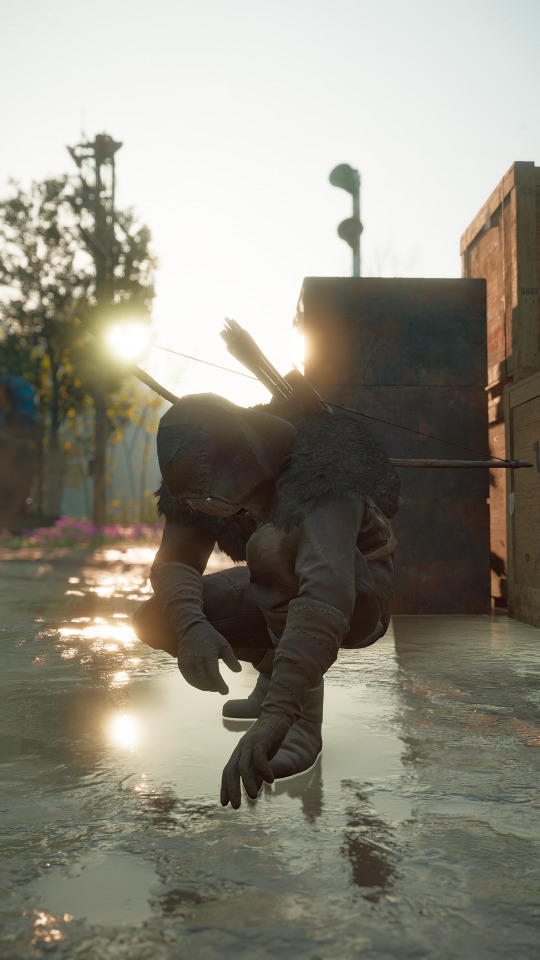
#surprise new dawn screenshots!#I love rolling the camera by 90 degrees to take 'fake' vertical pictures#in my opinion it’s better than using the 6x9 frame because the angle is wider#I just have to rotate my head and controller by 90 degrees too to accurately move the camera haha#far cry new dawn#the judge#new eden#bird#probably american crow but white#wolverine#my screenshots#far cry new dawn screenshots#far cry new dawn photo mode#photo mode
41 notes
·
View notes
Text
Solo Harr (ft. his pet owl): Bird of Doom
So discussions with @littlelady-blackwell and @theflowerwaltz had us talking about how awesome it would be if Harr’s pet is an owl like his birthday cake suggests....my brain went on a tangent about magic animals and then I wrote this ^w^ I named the owl Astrid and he is a good boi, a Japanese scops owl if people wanted to know specifics I even cross-referenced the pic of the owl on Harr’s cake to make sure it seemed believable. Hope you guys like my lil drabble~~ :3
The nights in Cradle stretch on in a never-ending blanket of midnight blues and greys lit only partially by the few stars visibly scattered in the sky. The moon hides, scared to show its light, seeking solace behind a wall of cloud. It’s dark, even darker still in the Forbidden Forest with the trees adding another barrier the light has to pass through.
Pupils dilate, eyes of a scorching inferno. A long ear twitches at a faraway sound, head rotating to better ascertain its location. The sound is easily distinguishable, for there is no other sound in nature that could replicate it. The sound of concentrated magic, its energy building and releasing with perfect poise and control. The head rotates back to its proper position, eyes blinking before propelling itself from its perch, wings spread without sound or presence. It weaves through the forest with unparalleled grace, only the softest of disturbances in the air from its quiet flaps, its feathers designed by nature in such a way to be unnoticed as it moves - a silent hunter, yet always listening.
Its ear twitches again, the sound of concentrated magic stronger. With grace and finesse, it lands on a branch high in the tree, folding its wings away neatly. It blends into its surroundings, the only giveaway of its presence being its eyes of blood red, an omen fitting for these so-called “birds of doom”. It watches from above, judging the man below with striking eyes. Three eyes glow red in the night, one unnoticing his feathered audience.
The slab of wood before him slices in two, the cut crisp and defined. Harr lets out a breath, his energy wavering being his sign to stop for the night. He can feel his hands tingling, the magic coursing through him begging for release. But he yields, knowing well not to push himself and his body too far. His eye closes, his blood red iris reverting back to its striking grey as he reopens it. As he bends down to gather the wood in his arms, the soft, repetitive sound of hoots fill the air, their echoes bouncing deep through the forest giving the illusion of a parliament of owls residing overhead. But Harr knows. There’s only one non-human creature who would actively seek him out.
His eye raises meeting the owl’s staring back, the previous deep red of its eyes now more of a deep twilight orange, its colour still beautifully contrasting against the dark of night.
“Astrid.”
Harr utters the owl’s name, the bird’s pinpoint-accurate hearing picking up his softly spoken word with perfect clarity. His talons release its hold on the branch, free falling before opening its wings to catch the air beneath it, gliding softly over to Harr, his arm waiting. Astrid lands on Harr’s arm, gripping just tight enough for security but ensuring its talons aren’t piercing flesh or clothes. Harr smiles softly, admiring the owl’s soft plumage of grey and white feathers as it puffs out his feather in a show of bravado.
“Ever the show-off, I see.”
Astrid blinks, his beak nipping against his feathers as he preens himself, Harr watching on with a softness in his eye. He looks down to the bird’s feet, noticing a small string wrapped around its leg with a tiny parcel attached. He blinks, eye moving up to meet Astrid’s waiting stare, the owl blinking as if to say, “Go on.”.
Carefully removing the string, he removes the package and opens the small slit at the top. His eye widens, mouth slightly agape in shock as his brain catches up to the contents of the tiny parcel. Pure, untouched Magic Crystals, their potential for magic unbridled when curated by professional hands. A soft coo from the owl draws Harr’s attention back to him, still resting comfortably on his arm, awaiting praise.
“It actually worked…” He breathes out, shifting the crystals in the parcel around, listening to the sound of the gems scraping lightly against the paper, “Now that we know animals have potential to harness magic like humans do, it looks like I need to keep a closer eye on you. If the Magic Tower catches wind of this, it won’t be enjoyable for you.”
Astrid seems uninterested, cocking his head at a 90-degree angle, his orange eyes wide as he stares at Harr. He sighs in response.
“Just be careful the next time I make you do this. Just like I trained you.”
He blinks, meeting his human’s one-eyed stare, holding silent affection and subtle worry. Astrid hoots softly, puffing his chest plumage out proudly. Smiling with relief, Harr reaches up and strokes the back of his finger against the bird’s head, scratching his long protruding ears. Astrid’s eyes close, leaning into the touch as he coos happily. With a final stroke to his soft feathers, Harr removes his hand.
“Thank you, Astrid. Now, go.”
He lifts his arm to give the owl the extra boost. His talons release their gentle hold on Harr’s arm and flap to gain height, the action soundless and still in the night air. Harr watches as the bird flies off into the night, eye trailing down to the parcel held tightly in his palm.
(It worked. After so few attempts. The thought makes me both happy yet worried. This is one aspect of magic that must remain hidden from everyone. Always.)
With that cryptic thought, Harr gathers the wood in his arms and makes his way back to his home, his ears picking up the soft hooting calls of his “bird of doom”.
#ikerev#ikerev fanfic#harr silver#original pet#I hope he has an owl dammit#it fits really well considering English folklore surrounding owls#also...I really love owls fjenufknsfils
29 notes
·
View notes
Text
An Introduction to Femdom in Virtual Reality
Preface: I wrote this up to explain the appeal of VR to people who’ve never experienced it before. If that doesn’t interest you, feel free to skip directly to my other post, The Best Femdom VR Experiences Out There.
What is VR?

If you haven't been living under a rock, you've heard of the resurgence of virtual reality (VR) in recent years.
To make it clear what VR is: it's a headset that straps to the back of your head. It contains two tiny screens, one for each eye, that display a virtual world. The use of dual screens creates depth perception. On top of that, the headset's rotation and position are tracked by the virtual world, so as your head moves, it moves in perfect sync with your virtual eyes. And it utilizes positional audio, so you can tell what direction sounds come from. Also, there are spatially "tracked" controllers that strap to your hands, which let you "put your hands in the virtual world".
For some people, this combination of immersive factors makes VR so "real" it overwhelms them. For most of us, it just feels like a more visceral experience--at a subconscious level, what we experience has a partial sense of reality. That's why VR porn also feels more "real"--not as real as if you saw it in real life, but if done properly, certainly more real than if you utilized a 2D screen.
The modern VR industry started with the "Oculus Rift" headset that finally launched in 2016, and now involves companies like Valve, Sony, Facebook, HTC, Samsung, Lenovo, Nintendo, and Google. On the software side, a few major studios like Insomniac Games have created some VR content, but for the most part it's just small and indie developers who make VR experiences. The industry has yet to truly "take off".
I would say there are 2 major reasons the industry has yet to fully break into the mainstream. First, there are space and technical limitations: you want at least 7 by 5 feet of open space, and for the sensors to be properly placed in sufficient number to accurately track the headset's and the controllers' locations in real time, and even then occlusion still happens. Second, the resolution (~1080x1200 for each of the 2 displays, but their view is mostly shared), field of view (~90-110 degrees), and refresh rate (70-90 Hz) have yet to reach the level where they feel as vivid as real life. Also, there aren't too many worthwhile VR experiences yet, and people are reluctant to bother to put on a headset, in this era where they'd even rather play their games on a mobile device.
Femdom in VR!? How does that work?

(Anyone else remember the X-Files episode First Person Shooter?)
VR is a versatile medium which, at the core, consists of bifocal video and spatial audio. So the types of femdom you can experience in VR are more diverse than you might expect.
Femdom Video
There are 4 types of video you can appreciate within VR. Important note: with VR video, even if you move your head forward and backward, you can't move "inside" the video, your viewport stays the same! Only rotating your head alters what you see. That's because VR video is filmed with special cameras which capture a wide field of view, but the cameras themselves are fixed in place.
1. Non-VR video: Yes, you heard me. There are many VR apps, such as desktop emulators and video player apps, which let you play non-VR video within VR. How? Of course, by creating a "virtual movie theater" in which a large flat screen appears in space, and the video is projected onto it. You can then move the screen itself through space to position it as close or far from yourself as you want, or as high/low left/right as you want. Keep in mind that the video is being projected onto tiny displays that are merely ~1080x1200. So the actual resolution will be closer to 720p, with some visual artifacts due to some imperfections in the optics of these headsets. However, you still have the same sense of "majesty" of a huge screen, as if you were really in a movie theater.
2. 180 degree 2D video: This refers to video that is like a half-globe around you. This is how it works: the camera utilizes a fishnet lens to capture a wide field of view, and stores it into a 2D video file as a warped image. The VR video player is told (or automatically detects) that it's VR video, and the VR video player "unwarps" the video to be spread onto the surface of the half-globe that surrounds you within the virtual world. Because the video circularly surrounds you and roughly matches the camera's broad field of view, it delivers a pseudo-3D effect, and almost makes you feel like you're inside of the video. But objects distort based on how close or far they are from the lens. And since it's only 180 degrees, if you look behind you, it's pitch-black.
3. 360 degree 2D video: This refers to video that is like a full globe around you. It's the exact same as 180 degree 2D video, except that if you turn around, it's not pitch black, there's more video.
4. 3D video: Video that doesn't feel flat, it actually has depth! That's because it was filmed with 2 cameras placed next to each other, one for each of your eyes. The effect is similar to 3D movies you can watch in a theater, but better. Note: If you try to play 3D VR video on your computer's ordinary video player, it will appear as 2 near-identical distorted videos stacked next to each other; it's effectively a "double" 2D VR video.
Femdom Simulation Games
The vast majority of femdom VR applications are more "experiences" than "games". That is, there's no real gameplay. You just load up the game, and you're placed into a virtual space where you don't move much. 3D models of dominant women will hover around you and tantalize you, and utilize a combination of femdom animations viewed from up close, sensual BGM, and sexy voice acting.
At least, that’s the minimum feature set. Some experiences are more interactive than others, for example.
Non-Femdom Games, With Incidental Femdom Elements
Some VR games have fanservice or erotic elements, like cute anime-style heroines who dress sexy to or say flirty words. A portion of their content may appeal to femdom fans. Alternatively, games can be modded to have femdom elements. In addition, it's possible to use VorpX to hack many non-VR 3D games to run in VR, although since they're not "made for VR" experiences, you may run into frame dropping and other technical issues. And some console emulators also support VR. So this opens up many more possibilities for femdom in VR.
By the way, as a heads up: Gameplay in VR usually consists of reflex-oriented gameplay that requires you to move your headset's view to lock onto objects quickly, shift your body a few steps within your small playspace, or operate a gamepad or tracked controllers.
So What Are The Games, Then?
This post was just a primer. Time to go from theory to practice! Go check out my other post The Best Femdom VR Experiences Out There to learn about the actual games you can play.
1 note
·
View note
Text
Vintage russki camera review - Zenit-B w/ Industar 50-2 f/3.5

Intro
I have a modestly sized family and most about every in it is/has been crazy about photography at some point in their lives. My father, in particular, has been in the cozy company of cameras since, like, forever. I've got a picture of him somewhere: a cheerful little lad, no older than a year, crawling around right next to my grandpa's trusty little rangefinder...
What does this have to do with anything? Well, today I'll be reviewing one of my dad's many old cameras - his trusty Zenit-B with an Industar 50-2 50mm f/3.5. He used this one as his 35mm camera of choice after his FED rangefinder, having abandoned it much later after moving on to Japanese SLRs. I actually accidentally bumped into this camera about a year ago in my older brother's attic. Turns out, my dad gave the camera as a present to my bro, who used it for a bit but ultimately forgot about its existence, having moved on to more modern snappers.
Imagine my surprise when I unearth the leather-case-clad tank-of-a-camera with a big bold Made in USSR stamped onto it. The thing was lightly used, lens had no malices typical of a subterranean attic-dweller (haze, fungus), nothing was seriously loose or wrong... until I popped it open to check shutter operation...
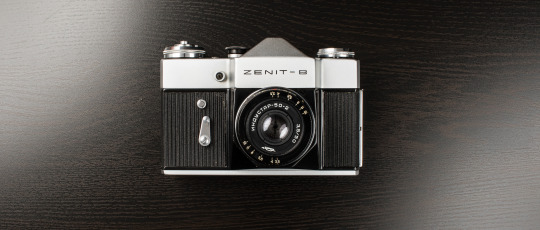
Design & build quality
The thing is built like a tank. Mass produced from 1968 to 1973. Rugged and over-engineered, and that is even before I tore it down to get inside and fix it. Inside it looked like it was built to withstand a nuclear blast. A Tchaikovsky Overture of heavy duty gearing, solid steel parts, heavy gauge springs, all tightly wedged against each other with thick flat head screws.
All the more baffling why, oh WHY did they bother to use simple glue to keep together the rubber-coated cloth shutter??? The most important piece of the puzzle, the cornerstone, the heart of the system... why was it made to be so weak? And it's not like there was a large amount of redundancy built into the mechanism - a little bit of glue going undone and the whole curtain self-destructs. Just don't get it.
Anyway, I had to hunt down a spare body with a functioning shutter on eBay to kindly act as a donor. As soon as the box touched down on my front porch the organ transplant was underway and not long afterwards my neighbors probably heard me go on a creepy "it's alive" howl. Frankenzenit was ready for action.
Apart from the shutter glue drama, the camera is a brick, chiseled out of the Terminator's spare parts. And there's just something about that Soviet design aesthetic that gets me every time. Like an old friend you'd sometimes like to forget, but can't. An eclectic mix of extreme cases of forms following function and the necessity for every single object in the country to be fixable with a skeleton toolset of dull screwdriver and hammer. Heck, most of the time even just the hammer was necessary.
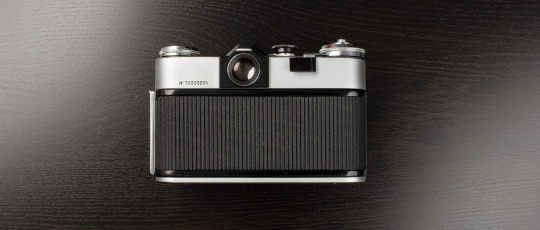
Tech specs
Under the covers it was all business and no frills. Barebones feature set, all manual, nothing extra. Shutter goes from 1/30 to 1/500 (the accuracy of which I can't attest to after seeing the mechanism up close and personal), has Bulb. Shutter knob has twist-proof mechanism, reminded me of something you'd find on a T-34 instead of a camera but it has a charm to it, adding an extra step to process.
Winder/shutter button combo with a built-in hand-resetable frame counter and provisions for a standard cable release. A rewind button and rewind/ISO memory wheel. Oh, and a self-timer. Mirror slap is not too obnoxious but don't expect to pull a ninja with this camera - loud and clunky. Next to zero foam in the body, the only seals are made of felt that are still going strong after 45+ years.
The lens is a copy of a Zeiss design, M42 mount, opens up to 3.5 and stops down to 16. Filter thread is, wait for it, 35mm in diameter. Good luck finding a pinch lens cap for it. More details on image quality further down the review.
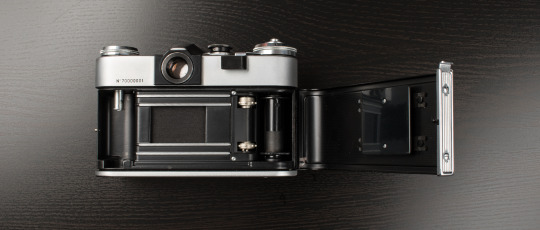
In use
Armed with a meter and a trusty roll of Ilford HP5+ @400 (I ran out of Tri-X at that moment), headed out Downtown with Kris from 43 Stories to see the sights and sounds of the Big City. From the sun-soaked vantage point of a 12-floor parking garage all the way down to chilly pale breeze of the distant skyline from the shores of Navy Pier, the 7-mile 6-hour walk took us all the way from Printer's Row, through the Loop on the L and onto River North, crossing the Magnificent Mile and into Streeterville. Crash at Navy Pier then back home.
Right from the beginning you get a sense that this will be a no-nonesense camera. Everything is roughly where you expect it. The gears are less ergonomic than its peers and the levers dig a little deeper into your skin, but the classic layout was a breather from some of the other cameras I've tested lately. Compact, easy to hold and grip, even with gloves. Aggressive knurling on the controls made fine manipulation easy. Everything clicks solidly.
In addition to the Victorian-Era steely thunderclap of a shutter, the camera has further handicaps that keep it back from being a street-smart photoninja. The shutter speed can't be set blindly, as there are no indicators of what speed you're on anywhere else but the knob. And to change speeds, you have to raise the knob, rotate it and plop it back into the correct setting. There are no physical clicks or stops when you rotate it, so unless you have super-dexterous fingers and a built-in angle meter accurate to the degree, you have to take the camera off of your eyes to readjust exposure.
Same goes for aperture, but this time it's even worse - camera needs to be focused wide open as the finder is too dim. And after you focus you'll most likely have to stop down the aperture. This cannot be done without peeling away from the camera and looking down at the aperture ring. It's clickless, so unless you have a sixth sense for degrees, you will need to look down. Forget quick turnaround time on the streets - this camera is a methodical shooter that requires planning ahead and patience, both from you and any animate object in front of you.
The viewfinder is pretty dim and features a regular ground glass - no fresnel circles in the center or any other focusing aids. With a f/3.5 lens it may not make that much of a difference, but any other lens with a larger aperture may require you to hunt quite a bit to nail that f/2 or f/1.4. Another minor (major, actually) annoyance is that the ring around the viewfinder is, just like most else on this camera, made of metal. Yours Truly Four-Eyes over here needs to first focus with glasses on, making sure not to have direct contact with the metal ring, then slide the glasses over to zoom the eye closer in to compose. The viewfinder optics are recessed deep into the body and it's impossible to see the entire viewfinder area coverage with glasses on. Haven't been able to dig up specs on viewfinder coverage but I have a hunch it's around the 80%-90% mark - I always saw extra features on the negs that I thought were long gone from the frame.
One final note about the viewfinder is that in the camera that I have, the viewfinder is misaligned horizontally, with a couple degrees of rotation to the right. Plain English: when the horizon is straight in my viewfinder, it's actually crooked in the actual photo. I haven't tested this with a bubble level yet, but people call me "human horizon" for a reason - I'm usually very, very careful with that. You hear horror stories about little irking details like this all the time with Soviet cameras, guess they've got some validity behind them, eh? Looking inside, I found no way of adjust the mirror or the ground glass. After peaking into the donor body, that one was misaligned as well, this time leaning to the opposite side.
The winder on this camera is an absolute beast. Quite literally. Be very, very gentle with it. Treat it real slow, nice and easy. The winder sprocket cams inside the body are born from a crude metal cast with razor-sharp edges on the teeth. I consider the Ilford HP5+ film base to be on the pretty durable side, yet even it has had ripped sprockets along most of the length. The winding lever has virtually zero feedback compared to modern cameras and Hulk-like leverage. The only way I was informed that I'd gotten to the end of the roll is when I heard a loud rip of the film from it's canister. Removing it required a dark changing bag. Apart from that expect to get 37-38 shots per 36 exposure roll. Film spacing is pretty consistent and film gate is at a slight angle but at least with no major light leaks (pressure plate still good after all these years).
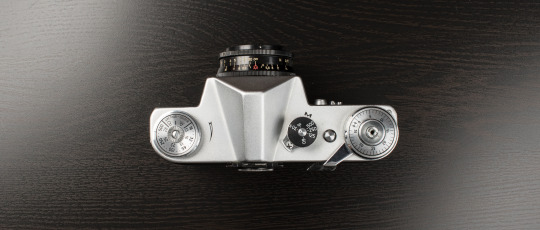
Image quality
So what do the images look like? They're pretty good, actually. I was expecting it perform a lot worse, but it is a knock-off of a Zeiss design, so that probably helps. First, the numbers. 3.5 is predictably soft, with decent center, medium vignetting and mildly mushy corners. Modern pixel peepers would consider this atrocious, but that's not what film aficionados are after, and to my eye it actually appears pleasantly vintage looking. I found the lens sharpest in the center by f/5.6, with f/8 improving the corners but starting to lose a bit in the center. F/11 exhibits a uniform image from center to corner, that's as in "uniformly soft", and f/16 starts looking like somebody took the photo and printed it on a rug made of low-denier fabrics.
Bokeh is minimal and can get quite busy unless you get REAL close to something. Wide open the bokeh is also quite swirly (couldn't find a more technical term), reminiscent of many vintage lens, where it looks like time and space itself are being bent around your subject matter. A look I actually quite like and one that is currently being revived thanks to Lomography's efforts with lens based on ancient optical formulas.
Flaring can be an issue, but the way the lens handles it is by dissipating the flare across the entire field of view, unlike some other lens where the flare affects the image only partially. I would assume this is because minimal, if any coating was used on the elements. I actually prefer this.
I was also quite surprised by the copious amounts of barrel distortion I noticed when photographing objects close up. I mean, come on - it's a 50, not even a 35! At infinity though, distortion is gone and buildings don't look like they're binging on burgers.
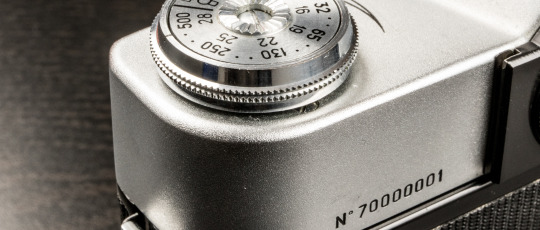
Conclusion
So, what do I think about a camera that has more misalignments than a knocked over vase that was superglued back together? The camera has a lot of sides the modern snapper would find archaic, impractical and irritating. It's a menace to film rolls and close ups of straight brick walls. It's an exercise in patience and meticulousness. And it's a lottery of settings and angles plagued by inconsistency and vagueness. But despite all this it still works, and works solidly. I am still surprised by the engineered heart failure on these cameras, but at a dime a dozen, there's no reason one should stay away from these exotic relics from a bygone world order.
PS: Did I mention that it's a conversation starter?
"Hello sir! May I make a portrait of you?"
"What kind of camera is that?"
"It's almost 50 years old, shoots black and white film and was made in the USSR!"
(eyes bulging in surprise)
"No way! Sure man, take as many as you like!"

Sample pics










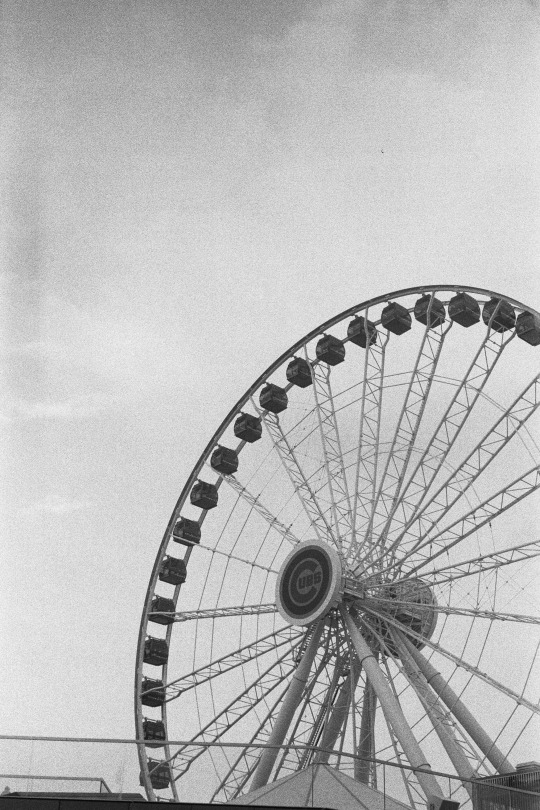







#film#analog#35mm#photography#vintage#camera#test#review#ussr#soviet#russian#zenit#zenit-b#industar#ilford#hp5 plus#chicago#downtown#black and white#bw#urban#street#navy pier
2 notes
·
View notes
Text
Maddox Rants - Gear VR
Some months ago, I talked about Google Cardboard.
Cardboard was a shoestring-budgeted VR headset that used your phone to render the image, display the image, run the games, and track your orientation, and for what it was, it wasn’t half bad. It had its problems, sure, but for the price it was a pretty decent deal. Since then, Google has gone on to create Daydream, which uses literally the exact same technology, but this time it has a controller that tracks only rotation and is $80. It’s like Cardboard in that it uses your phone for the tracking and is designed to be open so that many phones can work with it, which are ideas that we blatantly are not ready for in the mobile VR market.
That said, I haven’t yet tried Daydream for myself, but if past experience is to go by, it’s not exactly a great deal. I have, however, used its only real competitor, the Gear VR from Samsung and Oculus, extensively.
Just so you all know, I’ll be comparing it to the Cardboard more than anything.
The Hardware
The Gear VR works exclusively with recent Samsung phones, provided they aren’t called a Note 7. For many, including me, this is fine - more Android phones from Samsung are sold than any other brand. It’s just that if you don’t have one of those, you’re out of luck unless you can get one. I’m going to get some flak for this, I know, but I’m going to defend this decision. Remember Cardboard? That’s what happens when the hardware is designed to work with any phone. Since there’s no one phone or kind of phone to design for, it’s an incoherent mess of apps and immersion-breaking issues. I’ll get more into this later.
The unit itself is extremely light and comfortable. The straps are pretty easy to attach and are plenty sturdy, so that’s not a concern. On the right side is a touchpad used to interact with the interface without using a controller, a back button, and a home button on 2016 models such as mine. The device overall has very good build quality, which I expect with an asking price of $100 USD.
Here’s the important part, and the part that makes this distinctly different from Cardboard or Daydream: It’s not just a hunk of plastic. Instead of slotting in your phone and calling it a day, the Gear VR requires that you make use of a MicroUSB bit to insert your phone, and for good reason - it doesn’t use your phone’s gyroscope. This is huge for the immersion factor. Normal phone gyroscopes are often wildly inaccurate, allowing you to turn yourself around just by moving your head too much, but inside this HMD there’s a more accurate one. So far, I have had pretty much zero issue with being turned around while playing, and it’s such a big improvement. In addition, the slight delay I felt while looking around in the Cardboard is completely absent.
Inside the headset, the first thing I noticed is that the field of view is light years ahead of Cardboard or Daydream. The Daydream has 90° and my Cardboard viewer had 80°, which really still isn’t enough. The consumer versions of the Gear VR have 96° and 101°, which is both a lot better and allows me to make a six degrees of separation joke. With the 101° view of the HMD I have, the content fills almost my entire field of view instead of just a fraction of it. This makes it a lot more immersive, but also makes there be a pretty irritating screen-door effect. Rumors say that the S8 will have a 4K screen, though, which would pretty handily fix that. Of course, this is all irrelevant if there’s a problem with...
The Software
This is what matters, and what separates this the most from the other mobile offerings. The Gear VR has, and I cannot stress this enough, games that are actually good games. Like, legitimately fun. If we’re being totally honest here, the only game I actually had fun with in Cardboard was Half-Life 1. Sure, the others were neat distractions, but that was the only one really worth sitting down and playing. The Gear VR (I am really sick of typing that name) does in fact not have that problem, as I will demonstrate with some more of the crowd-favorite mini-reviews.
DRIFT
DRIFT is a neat little game where you play as a bullet weaving your way around a totally not Superhot world. It’s kinda cool I suppose. I would absolutely recommend buying it, though - or, rather, I’d recommend buying the Oculus Games Starter Pack. It’s only about ten bucks, and it includes four pretty great VR games. If you get this, be sure to pick that up with it. Rating: Good
Hitman GO: VR Edition
Another game in the Starter Pack, Hitman GO is almost really good in VR. I say this because while the game is fun, the VR controls kinda suck. Also, apparently it’s not working on a lot of people’s phones, but it does work on the Galaxy S7, so there’s that. Rating: Okay
Darknet
Yet another game in the bundle, Darknet is really good in VR. It’s a puzzle game where you have to strategically hack into networks through a pretty good minigame. Rating: Great
Esper 2
Being the final game from the bundle as well as the one I was interested in the most, Esper 2 is a VR game done right. Unlike many other VR games, it’s a legitimate game, with an interesting plot, great writing, well thought out controls, fun puzzles, and a playtime of a few hours. If you have or will have a Gear VR, get it. Rating: Must-Have
Minecraft: Gear VR Edition
Know those games that are exactly what they sound like? You know, stuff like Final Fantasy Tactics or “oh there’s a new CoD coming out.” This is one of those. It’s Pocket Edition in VR. It even has support for multiplayer with the other versions of PE as well as the Windows 10 Edition, which is a very nice touch! Rating: Must-Have
Overflight
Okay, so, you’re in a plane, right? And around you are, like, other planes. So basically, those other planes are controlled by other players, and they want you super very dead. You’re all in Spitfires, so you have a bunch of fun flying around and shooting each other, and that’s about it. That’s Overflight. I love it. It’s my go-to game for showing the Gear VR to people for the first time because it’s so simple and fun. Rating: Must-Have
Temple Run VR
I mean, this one is free, so it’s obviously a must, but it’s pretty fun either way. Another game that’s exactly what it sounds like, but it has the problem of not letting you spend coins on anything, which would be really helpful. It’s fine, though, since it’s still, you know, free. Rating: Must Have
Vendetta Online VR
Discount Elite Dangerous! If that sounds fun, then it’s pretty dang good for $3. Rating: Great
Did you notice a pattern there? All of these games are either decent or incredible. That’s fantastic! It has good games! They overcame the great hurdle of VR!
I would. however, recommend that you get yourself a controller to use for this. I went with the Moga Pro Power, and while it’s a great controller, it doesn’t work with some non-VR games and the B button is sticking for some reason, but that’s just a fault with the unit I got. It also works as a decent battery bank, too, if that seems helpful, so if you can live with its problems, that may be the way to go.
It terms of the actual user interface, it’s all pretty intuitive. You never need to to take off the HMD, since you can switch apps, visit the shop, and do whatever else you may want to do all from the Oculus Home within it. At any time within a game, you can hold the back button to open up a quick menu; I’d probably compare it to something like the pop-up menu of the Xbox 360 or the Steam Overlay. From here, you can do all sorts of things, like manage friends, quit the app, reorient yourself, and even start recording gameplay. Annoyingly, the recorded footage has no sound, but the picture is sharp, runs at 60 FPS, and doesn’t create really any lag, so I’ll give it a pass on that one. If nothing else, it’s certainly a lot better than my Cardboard solution! As an example, here’s some footage of me playing some classic games in Oculus Arcade:
youtube
So, the software side is good, and the hardware side is good, so is there any really big problems I’ve encountered?
Well... no, actually. I have pretty much no problems with the Gear VR. It’s just an all around great product for anyone interested in VR who has a recent Samsung phone. It’s the only HMD I’ve tried so far where I’ve actually felt like I was actually there. I’m excited to see where Samsung and Oculus go with this, even if I completely loathe the latter.
So, what’s next?
Well, I guess the next logical step would be the Oculus Rift or the Vive, but the problem with that is that those are several times more expensive than anything I’ve got so far and that my computer can’t actually power either of those, since I only have a GTX 960 and a FX-6300, so that’s out of the picture. Besides, I’d end up having to get the Vive anyway, since I both hate Oculus and think that the Rift is a complete rip-off, so that’s eight times what was already very expensive to me. That leaves us with the Daydream, but that would also require buying a new phone.
I suppose, then, that this is the end of my VR headset odyssey, at least for now. Of course, I will absolutely review any interesting games or apps I find for the Gear VR, so rest assured on that count. Besides, it’s not like there won’t be new HMDs and new phones to test them with - heck, soon we may even have high-quality hand tracking with a mobile version of the Leap Motion, a groundbreaking technology that the Rift foolishly chose to reject, hitting the Gear VR, and if what I’ve seen is anything to go by, I’ll be the first in line.
4 notes
·
View notes
Text
Plantronics Backbeat Pro 2 vs. Sennheiser HD 4.50
There’s no denying the fact that wireless headphones may seem to cost you a fortune at times, but when you think of the freedom they offer in terms of mobility and a clutter-free musical experience, they are worth a shot. Whatever is your reason to upgrade to a pair of wireless headphone, I get an opportunity to help you choose. And today we are comparing two pairs of wireless headphones from two camps, the Plantronics Backbeat Pro 2 and Sennheiser HD 4.50.
Plantronics and Sennheiser are two international brands and the competition is quite rough because of the features these two come packed with. The Plantronics Backbeat Pro 2 and Sennheiser HD 4.50 BTNC wireless noise cancelling headphones seems formidable opponents in the wireless headphone category. However, audiophiles will be happy that I picked these two for comparison. There is a clear winner by a slight margin. So, read on!
Build
The Sennheiser 4.50 BTNC fondly knows as the HD 4.50 is a sturdy bad boy. Going over the physical features, the headphones are all plastic, but not the cheap-feeling plastic. They are well made; they don’t rattle or feel finicky. They feel like a confident product to test. The headband is covered with little padding but does not affect comfort. The ear cups fold in neatly for storage into the included fabric carry-case.
Speaking of Plantronics Backbeat Pro 2, you get a nice carry pouch with the headphones to tuck it away safely inside. In the box (cloth bag), you find an audio cable, a USB charging cable and the instruction book and warranty information. When it comes to build quality, the Plantronics Backbeat Pro 2 feels solid and little more refined than their previous versions. They are slimmer than both their original and the Backbeat Pro plus.
As far as design goes, these aren’t the prettiest headphones but the plastic around the ear cups has a textured pattern to it. The headphone padding is a dark brown that gives the headphones a more professional look. The fake wood pattern on the outside of the ear cups may, at first, feel out of place and might not be for everyone, but it may grow on you over time.
One other aspect of the headphones that the Plantronics Backbeat Pro 2 doesn’t have is the ability to fold. The ear cups do swivel 90 degrees; so it is easy to slide them back into the carrying pouch once they are flat. However, if you are looking to save space in your bag while traveling or commuting you might have an issue with these.
Comfort
Moving on to comfort, the Sennheiser 4.50 seems clampy at first but soon you get used to the full size headphones. It was a subjective judgement as the new pair of any headphone does feel a little tight straight out of the box. However, the jawline pressure and wear-fatigue disappears with use and can be worn for extended periods of time without any issue. Weighing a 236 grams, the Sennheiser 4.50 can feel a little clampy if you have a sensitive head/ jawline.
The Plantronics Backbeat Pro weighs a little more than 289g and is a little bulky but manageable than their previous versions and mostly made of plastic. The pleather padding on the earcup and the headband feels smooth and gives it a premium look. The bottom portion of the headband is even made with a breathable mesh and adjustable bands. The overall feel is good but u feel a weight on your crown when you use it for extended periods of time.
Controls
One of the main themes of the Plantronics Backbeat Pro 2 series is the level of control that the user has over their music without needing to reach for a source device. That trend continues here with buttons, switches, and rotating wheels all over the place. On the right ear cup, there is a multi-function button on the side, micro USB and 3.5-millimeter inputs on the bottom and then a button and a switch along the edges.
The left ear cub has a single switch along the edge with playback buttons on the side and a rotating volume control ring. The Plantronics Backbeat Pro 2 is easy enough to connect and it does have NFC, so you should not have a problem if you have a compatible device. The backbeat pro tools do have a confusingly robust set of switches and buttons but they let you control, basically everything, without actually needing to use your smartphone. You can play/pause music, skip between tracks or adjust the volume using the controls on the left ear cup. You can also access any personal assistance or answer phone calls by pressing the button on the right side of the ear cup. If you take off the headphones, sensors in the ear cup will detect that they’ve been taken off your head and music will pause automatically.
When we look at the Sennheiser HD 4.50 controls, the right ear cup has the power ON/OFF, a very smooth multi-function switch below the power button that allows you to skip and go back and forth on music tracks. The same button is also used to answer calls, which we tested in a public place and found that voice wasn’t very clear to the user on the other end. Light to moderate background noises are picked up by the headphone. There is a 2.5 mm port for wired connection and Sennheiser does offer a locking wire cord, so that the pin is not yanked out while in use. To charge the Sennheiser 4.50, a micro USB port is available.
Battery
The Sennheiser 4.50 has a battery life of up to 25 hours with ANC off. With ANC, Sennheiser HD 4.50 gives up to 19 hours of use. If you connect these headphones to your PC, it charges automatically and do not require any driver installations. One important piece to note is that the headphones switches off while charging and you cannot use them.
Plantronics claims a battery life of 24 hours of constant playback, which seems to be true in my tests as well. Tapping the button on the right ear cup when you’re not wearing them will also illuminate a tiny indicator, so you know roughly how much juice it has left.
Active noise Cancelation
Jumping on to the ANC performance, I found the Sennheiser 4.50 worked absolutely fine, but not as great as the Bose Quiet Comfort, especially outdoors in coffee shops and public spaces, where I wore them continuously for a day as a part of this testing. A rocker button activates the ANC on Sennheiser HD 4.50 when using them wirelessly.
The Plantronics Backbeat Pro has a switch to turn on or off active noise cancellation as well as the open mic mode. This uses the microphones in the headphones to let sound in so you can hear what’s going on around you while the ANC is switched on. These are ANC headphones but the Backbeat Pro 2 just cuts the outside and ambient noise by half when compared to other premium headphones including the HD 4.50.
Connectivity
One of the standout features of the Plantronics Backbeat Pro 2 series is the solid wireless range they offer. They have class 1 Bluetooth, which means you can stream music up to about a 100 feet and in our testing we got a little under 80 but that’s still pretty good.
NFC, apart from Bluetooth, is one of the features available on the Sennheiser 4.50 for streamline pairing. Bluetooth connectivity is very strong on these on-ear headphones and works with houses or brick-walled areas with ease and personally, I did not experience any break in sound or quality while moving around in the house or office areas.
Sound quality
Speaking of sound, the Plantronics Backbeat Pro 2 has a decent low end but they are a little too big sounding when compared to our contender today. Songs with deep base thumps or rumbling noises tend to sound a little muddy. It doesn’t feel bad but there is noticeable audio bleed if you are in a silent room. They often give a pretty nice balance with good amount of detailing without piercing through your ear drum in the volume levels of 50% to 70%. The airy reverb and the highs got cut down a little, but even on max volume they were comfortable to listen.
The Sennheiser 4.50 provides a very balanced audio experience – accurate and clean is what you are going to get. The bass is neutral and not altered or base-boosted, the mids are equal with the other high frequency responses and does not come as bright or recessed either. However, I wished for a little more resolution and detail in the mid-range for a more vibrant experience. From a consumer’s point of view, I am confident that these microscopic aspects will be hardly visible (I mean audible) and can pull up a great deal of romance with whatever you listen. The highs does have roll-offs and plays it quite safe because it doesn’t come anywhere near ‘tin-y’ (metallic like that of tin reverbs) and sharp, which is good. The 4.50’s are very easy to listen to without any listening fatigue.
Now let’s condense it in a table so that you can have a quick pick:
Brand Plantronics Backbeat Pro Sennheiser HD 4.50 Model Backbeat Pro 2 HD 4.50 Build quality Premium and heavy Premium, strong, lightweight Earcups Pressure on the crown and ears Clampy but manageable Gross Weight 289 grams 236 grams Type Wireless Wireless Controls Built on to the ear cups; buttons and volume ring to control tracks and audio Rocker button and traditional buttons Noise Cancellation Technology Active with open mic option Active ANC Performance Average Comparatively better Quick charging – – Battery (usage time) 24 25 Equalizer Mic Open mic mode; inbuilt and sensitive Excellent audio clarity Bluetooth Version 4.0 4.0 Bluetooth Range 100 m – Included in the box Carry case, micro USB charging cable and 3.5 mm audio jack Carry case, charging cable and 2.5 mm audio jack Sound Quality Average Excellent
Sennheiser HD 4.50 stands out as the winner between Plantronics Backbeat Pro 2 and Sennheiser HD 4.50 by a tiny margin. Hope you enjoyed this detailed comparison; stay tuned for more updates. Signing off for today, have a great day.
The post Plantronics Backbeat Pro 2 vs. Sennheiser HD 4.50 appeared first on Wireless Headphones Guru.
from Wireless Headphones Guru https://wirelessheadphones.guru/facts/plantronics-backbeat-pro-2-vs-sennheiser-hd-4-50/
0 notes
Text
Open Water Swimming - For Beginners
I figured out how to swim in a lake where my family lived, in northern Wisconsin. My kin and I prepared summer exercises in untamed water since the closest pool was a thirty moment drive and our back yard was more advantageous. Because of this inundation, it didn't appear to be peculiar when I contended in my first vast water race in Seal Beach, California, in my late twenties. Untamed water swimming has been an endless enterprise. Some of my most loved recollections are from swims; leaving from Catalina Island for the California terrain at 1 am on a windless moonlight night, viewing the brightness gleam as my arm pulled through the water and fish dashed underneath; swimming pair with my better half, Dave, outlined against the excellent blue Caribbean water off the shore of St. Lucia. Different recollections incorporate the feeling of dread before starting a 42 kilometer race in Newport Vermont, which travels north up Lake Memphremagog towards Canada and a "foggy" memory (because of gentle hypothermia) of completing in Calais, France subsequent to intersection the English Channel. There was additionally the elation of overcoming extreme chilly conditions or vast waves and cleave, swimming and completing races regardless of mother natures' lack of interest to my situation.
There is a flexibility and test swimming in vast water which can't be knowledgeable about the pool. Is it accurate to say that you are prepared?
How to start?
Alright, swimming in untamed water is your objective, where do you begin? I will expect that you definitely know how to swim. If not, take a few lessons, join a YMCA or a bosses swimming group and take in the crawlstroke/free-form.
There are a couple of things that you can do in the pool to get ready for swimming in vast water; respective breathing, head lifting and stroke rate preparing.
Above all else, breathing on the two sides, or respective breathing, is an unquestionable requirement. (I can hear the groans!!!) Let's check whether you are physically skilled. Stand up and contort the upper portion of your body to one side and after that to one side. At that point turn your make a beeline for the privilege and left. SCHEZAM!!! You can figure out how to inhale to the two sides. Why is this fundamental? Envision or play out the accompanying analysis. Locate an open space around 400 yards in length. Select an objective and attempt to walk straight towards it EXCEPT close your eyes and turn your head, looking to the privilege each 2 stages. Sneak a look forward each 10 stages. Vision in the water will be considerably more confined than this since you might possibly have the capacity to see forward contingent on wave conditions, haze in your goggles or glare from the sun reflecting off of the water. This is additionally accepting strict fixation upon straight line swimming - not envisioning that shadows are sharks and weeds are snakes-which will enhance with training.
Breathing on the two sides fulfills two principle objectives. It has a tendency to "try and out" your stroke with the goal that you will normally swim straighter. Ha, ha, you definitely KNOW how to swim straight, isn't that so? However, that is in the pool. Think about the accessible signals, path lines as an afterthought and a dark line on the base to manage your advance. Untamed water is entirely different. Notwithstanding the absence of visual signs accessible in the pool, the water is colder, there may be a few waves and the 'pool length' can be the length of a mile!
The second favorable position to respective breathing is that it will enable you to see to one side and left. When swimming in the sea, the typical course crosses down and back along the shoreline. On the off chance that you just inhale to the other side, half of your race will have NO obvious signals toward the shore. Viewing the shoreline is to a great degree accommodating for straight swimming in the sea.
Different favorable circumstances incorporate having the capacity to breath far from approaching waves or exhaust from water crafts amid escorted swims.
Another aptitude to hone in the pool is lifting your go to see forward while swimming. The most straightforward route is to lift your head forward just before slowly inhaling to the side. I utilize the forward movement to look and after that inhale to the side. Breathing head forward is not proposed since it requires excessively vitality to lift the head sufficiently high for a breath and will cause slower swimming. Swim head up free-form in the pool and perceive how troublesome it is contrasted and head down swimming.
Attempt to get settled with this look forward in the pool where it is generally quiet. It will be more troublesome in vast water, particularly in the sea.
How regularly is it important to look forward? That relies on your straight line swimming capacity combined with and course conditions. In a perfect world, the less head lifting, the better, yet swimming off base is likewise not worthwhile. At first, attempt just looking forward each 10 strokes (each arm considers one).
Temperatures in vast water are normally colder and may require a speedier stroke rate, - how much time it takes to finish your arm pull-. In untamed water, stroke rate is controlled by checking once for each arm as it begins pulling through the water.
The rate is controlled by checking each arm stroke for one moment (or meaning 30 seconds and increasing by 2, or meaning 15 seconds and duplicating by 4). The best untamed water swimmers on the planet have stroke rates in the vicinity of 70 and 90 strokes for each moment, with ladies by and large on the higher end of that scale. A speedier stroke rate will help with keeping a swimmer hotter in frosty water. Have a companion time your rate in the pool. On the off chance that it is under 60, you might need to chip away at expanding it to better deal with colder temperatures.
Try not to get disappointed if expanding your stroke rate is troublesome. Individuals for the most part don't have a day by day action where their arm muscles work out 'vigorously'. Swimmers create "vigorous arms" through years of preparing. A runner's oxygen consuming capacity may not consequently exchange to the pool where the arms are the essential engine rather than the legs. In like manner, I can swim serenely at 80 strokes for every minutes following quite a while of preparing, however keep an eye out in case I'm out running; my toiled breathing can be heard miles away.
I have one more recommendation with which some mentors may dissent; adjusting the stroke recuperation. The "recuperation" is the means by which a swimmer brings the arm out of the water and back to the front in the wake of finishing a stroke. Ordinarily mentors instruct swimmers to forcefully twist their elbow amid the recuperation. This for the most part conveys the hand near the surface of the water. This kind of recuperation may not fill in too in waves. A dominant part of vast water marathon swimmers utilize a straight arm recuperation instead of a twisted elbow recuperation. I trust a straight arm recuperation works better in waves and furthermore diminishes strain on the shoulder. The pectoral muscles work more to recuperate the arm when it is straight while the shoulder and rotator sleeve muscles work more to recoup the arm when it is twisted at the elbow. Explore different avenues regarding your recuperation and see what works best for you, bowed, straight, or some place in the middle. The sum total of what sorts have been utilized by quick swimmers and world record holders; Janet Evans being a prime case.
Gear
The essentials, top suit and goggles are the same with some little varieties. A thicker top (made of silicon rather than latex) may be desirable over keep the head hotter. At times a swimming top does not remain on extremely well and ceaselessly slips. This can be greatly irritating amid a race. Have a go at wearing another top which isn't extended. Another tip, keep away from hair conditioner for a few days before a race. Conditioner makes the hair elusive and enables the top to slide. In the event that the water and air are hot, and your hair short, a top may not be fundamental. Tinted goggles which mirror the sun and diminish glare can likewise be useful, yet they are not a need.
An extraordinary bathing suit is a bit much in spite of the fact that teasing is a thought while choosing your clothing. Rub blemishes on the skin from the suit and body parts can happen and are likely in salt water. The more salt, the more rubs. When I swam the12 mile race around Key West, the water was salty to the point that the greater part of the creases of my suit makes rub marks which was extremely strange. Rub zones incorporate the armpit, internal thighs, neck and bust line. Ladies have more inconvenience as a result of their suits at the neck and bust line close to the armpit. Men can experience difficulty where their facial hair or stubbles rub against their neck and arms. Vasoline, lanolin, sack medicine or other oil can be utilized to counteract scrape marks. For amateurs, apply oil in the armpit, neck and inward thigh. In the event that rubs will happen in different regions, you'll discover "where" after a couple of preparing swims. A few swimmers utilize gloves, a cloth or even a stick off the shoreline to apply oil without getting it staring them in the face. Oil on the hands can without much of a stretch get on the goggles and cloud your vision. In the event that you are wearing a suit which speeds up the back, the zipper at the best frequently rubs the skin. Sewing a little bit of felt or chamois fabric between the zipper conclusion and skin will forestall teasing.
Likewise, bear in mind sunblock on the off chance that you are out amid crest sun hours. Test and discover what works best for your skin. Waterproof does not really imply that the square will work for a considerable length of time. On the off chance that you are arranging a long preparing swim, attempt to begin at a young hour in the morning before the sun's beams achieve their pinnacle.
To start with vast water attack.
Since you have drilled two or three aptitudes, you are prepared for your first untamed water swim. Your area will direct which locales are accessible. Be shrewd for your first begin. On the off chance that it is down-pouring and cool with 20 mile for every hour winds, put your swim off to one more day.
Research the site where you intend to swim. Wellbeing ought to dependably be your first need. Are there lifeguards on obligation? In the event that yes, let them know your swim designs; heading, time as well as separation. If not, don't swim alone. Have somebody kayak, oar, swim or walk the shore along your side. Attempt to remain nearby to shore in water profundity where you can stand unless the sea surf directs something else. Discover the water temperature so you will have a superior thought what's in store. Are there dangers, for example, tear streams in the range?
0 notes